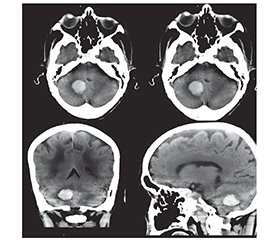Международный неврологический журнал Том 20, №4, 2024
Вернуться к номеру
Звіт про випадок геморагічного інсульту на тлі фібриляції передсердь у поєднанні з гіпертонічною хворобою
Авторы: H.P. Samoilova, O.V. Markovska, O.L. Tovazhnyanska, M.S. Myroshnychenko, V.O. Bibichenko, H.O. Sakal
Kharkiv National Medical University, Kharkiv, Ukraine
Рубрики: Неврология
Разделы: Клинические исследования
Версия для печати
Актуальність. Інсульт є гетерогенним синдромом, і визначення факторів ризику та лікування залежить від його патогенезу. Відомо, що захворювання серцево-судинної системи є факторами ризику розвитку гострих порушень мозкового кровообігу. Згідно з останніми дослідженнями, третина всіх ішемічних інсультів є кардіоемболічними. Фібриляція передсердь та гіпертензія часто співіснують, підвищуючи ризик тромбоемболічних ускладнень і серцевої недостатності. Основною ж патоетіологією геморагічного інсульту у вигляді внутрішньомозкових крововиливів є хронічна гіпертензія та церебральна амілоїдна ангіопатія. Виникнення геморагічного інсульту на фоні фібриляції передсердь у поєднанні з артеріальною гіпертензією є досить рідкісним явищем і створює проблему у виборі стратегії лікування. Метою дослідження було визначення оптимальної тактики лікування складного випадку геморагічного інсульту на тлі фібриляції передсердь у поєднанні з гіпертонічною хворобою. Матеріали та методи. Ми представляємо клінічний випадок геморагічного інсульту, що розвинувся у 84-річної жінки на тлі фібриляції передсердь у поєднанні з гіпертонічною хворобою. Основним питанням, яке постало перед кардіоневрологічною командою, було призначення пероральних антикоагулянтів. З одного боку, пацієнтка мала показання до їхнього призначення згідно з чинними клінічними настановами (оцінка за шкалою CHA2DS2-VASc 6 балів), з іншого боку, наявність геморагічного інсульту є протипоказанням. Результати. Цей випадок демонструє вирішення складного питання щодо вибору тактики лікування геморагічного інсульту й профілактики вторинних ускладнень фібриляції передсердь у поєднанні з артеріальною гіпертензією. Після проведення медикаментозної кардіоверсії з огляду на клінічні рекомендації щодо лікування геморагічного інсульту, а також позитивну динаміку неврологічного статусу пацієнтці було призначено апіксабан у дозі 2,5 мг 2 рази на добу під контролем коагулограми з 7-го дня від початку захворювання. Висновки. Ми вважаємо, що необхідно ретельно проводити неврологічний огляд та оцінку когнітивних функцій в усіх пацієнтів із фібриляцією передсердь, а також розглядати виконання нейровізуалізації до призначення антикоагулянтної терапії. Ми рекомендуємо розглянути призначення пероральних антикоагулянтів пацієнтам після внутрішньомозкового крововиливу, які мають низький ризик його рецидиву й високий ризик розвитку тромбоемболічних ускладнень.
Background. Stroke is a heterogeneous syndrome, and identification of risk factors and treatment depends on the specific pathogenesis of the disease. Cardiovascular diseases are risk factors for the development of acute disorders of cerebral circulation. According to recent studies, one third of all ischemic strokes are cardioembolic. The main pathoetiology of a hemorrhagic stroke in the form of intracerebral hemorrhages is chronic hypertension and cerebral amyloid angiopathy. The occurrence of a hemorrhagic stroke against the background of atrial fibrillation in combination with hypertension is a rather rare phenomenon and poses a problem in the choice of treatment for such patients. The aim was to determine the optimal treatment for a complex case of a hemorrhagic stroke with atrial fibrillation in combination with hypertension. Materials and methods. We present the clinical case of an 84-year-old woman who developed a hemorrhagic stroke on the background of atrial fibrillation in combination with hypertension. The main issue the cardio-neurological team faced was the administration of oral anticoagulants. On the one hand, the patient had indications for their administration according to current clinical guidelines (CHA2DS2-VASc score of 6 points); on the other hand, the presence of a hemorrhagic stroke is a contraindication. Results. This case demonstrates the solution to the difficult issue of choosing treatment for a hemorrhagic stroke and prevention of secondary complications of atrial fibrillation in combination with hypertension. After medical cardioversion, using clinical recommendations for the treatment of a hemorrhagic stroke, as well as given the positive dynamics of the neurological status, the patient was prescribed apixaban at a dose of 2.5 mg twice a day under the control of a coagulogram from the 7th day of the disease onset. Conclusions. We believe it is necessary to perform a thorough neurological examination and assessment of cognitive functions in all patients with atrial fibrillation, as well as to consider neuroimaging prior to the prescription of anticoagulant therapy. We recommend considering the administration of oral anticoagulants to patients with a low risk of recurrence and a high risk of thromboembolic complications after intracerebral hemorrhage.
внутрішньомозковий крововилив; аритмія; гіпертонічна хвороба; діагностика; лікування
intracerebral hemorrhage; arrhythmia; hypertension; diagnosis; treatment

